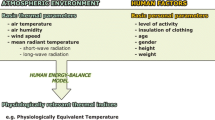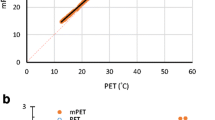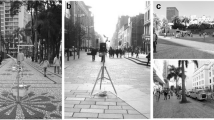Abstract
A new thermal index, the modified physiologically equivalent temperature (mPET) has been developed for universal application in different climate zones. The mPET has been improved against the weaknesses of the original physiologically equivalent temperature (PET) by enhancing evaluation of the humidity and clothing variability. The principles of mPET and differences between original PET and mPET are introduced and discussed in this study. Furthermore, this study has also evidenced the usability of mPET with climatic data in Freiburg, which is located in Western Europe. Comparisons of PET, mPET, and Universal Thermal Climate Index (UTCI) have shown that mPET gives a more realistic estimation of human thermal sensation than the other two thermal indices (PET, UTCI) for the thermal conditions in Freiburg. Additionally, a comparison of physiological parameters between mPET model and PET model (Munich Energy Balance Model for Individual, namely MEMI) is proposed. The core temperatures and skin temperatures of PET model vary more violently to a low temperature during cold stress than the mPET model. It can be regarded as that the mPET model gives a more realistic core temperature and mean skin temperature than the PET model. Statistical regression analysis of mPET based on the air temperature, mean radiant temperature, vapor pressure, and wind speed has been carried out. The R square (0.995) has shown a well co-relationship between human biometeorological factors and mPET. The regression coefficient of each factor represents the influence of the each factor on changing mPET (i.e., ±1 °C of T a = ± 0.54 °C of mPET). The first-order regression has been considered predicting a more realistic estimation of mPET at Freiburg during 2003 than the other higher order regression model, because the predicted mPET from the first-order regression has less difference from mPET calculated from measurement data. Statistic tests recognize that mPET can effectively evaluate the influences of all human biometeorological factors on thermal environments. Moreover, a first-order regression function can also predict the thermal evaluations of the mPET by using human biometeorological factors in Freiburg.













Similar content being viewed by others
References
Bauche JP, Grigorieva EA, Matzarakis A (2013) Human-biometeorological assessment of urban structures in extreme climate conditions: The example of Birobidzhan, Russian Far East. Adv Meteorol Article ID 749270:1–10
Blazejczyk K, Epstein Y, Jendritzky G, Staiger H, Tinz B (2012) Comparison of UTCI to selected thermal indices. Int J Biometeorol 56:515–535
Bröde P, Fiala D, Błażejczyk K, Holmér I, Jendritzky G, Kampmann B, Tinz B, Havenith G (2012) Deriving the operational procedure for the universal thermal climate index (UTCI). Int J Biometeorol 56:481–494
Fiala D, Lomas KJ, Stohrer M (1999) A computer model of human thermoregulation for a wide range of environmental conditions: the passive system. J Appl Physiol 87:1957–1972
Fiala D, Lomas KJ, Stohrer M (2001) Computer prediction of human thermoregulatory and temperature responses to a wide range of environmental conditions. Int J Biometeorol 45:143–159
Fiala D, Havenith G, Bröde P, Kampmann B, Jendritzky G (2011) UTCI-Fiala multi-node model of human heat transfer and temperature regulation. Int J Biometeorol 56:429–441
Gagge AP, Stolwijk JAJ, Nishi Y (1971) An effective temperature scale based on a simple model of human physiological regulatory response. ASHRAE Trans 77:247–257
Gagge AP, Fobelets AP, Berglund LG (1986) A standard predictive index of human response to the thermal environment. ASHRAE Trans 92:709–731
Havenith G, Richards MG, Wang X, Brode P, Candas V, den Hartog E, Nocker W (2007) Apparent latent heat of evaporation from clothing: attenuation and “heat pipe” effects. J Appl Physiol 104:142–149
Havenith G, Fiala D, Blazejczyk K, Richards M, Bröde P, Holmér I, Jendritzky G (2012) The UTCI-clothing model. Int J Biometeorol 56(3):461–470
Höppe PR (1984) Die Energiebilanz des Menschen. Wiss Mitt Meteorol Inst Univ München 49
Höppe P (1993) Heat balance modelling. Experientia 49:741–746
Höppe PR (1999) The physiological equivalent temperature—a universal index for the biometeorological assessment of the thermal environment. Int J Biometeorol 43:71–75
Höppe PR (2002) Different aspects of assessing indoor and outdoor thermal comfort. Energy and buildings 34:661–665
Jendritzky G, de Dear R, Havenith G (2012) UTCI—Why another thermal index? Int J Biometeorol 56:421–428
Kruger E, Bröde P, Emmanuel R, Fiala D (2012) Predicting outdoor thermal sensation from two field studies in Curitiba, Brazil and Glasgow, UK using the Universal Thermal Climate Index (UTCI), in: WINDSOR CONFERENCE 2012-The Changing Context of Comfort in an Unpredictable World
Lin TP, Matzarakis A (2008) Tourism climate and thermal comfort in Sun Moon Lake, Taiwan. Int J Biometeorol 52:281–290
Lin TP, Matzarakis A (2011) Tourism climate information based on human thermal perception in Taiwan and Eastern China. Tour Manag 32:492–500
Lopes A, Lopes S, Matzarakis A, Alcoforado MJ (2011) The influence of the summer sea breeze on thermal comfort in Funchal (Madeira). A contribution to tourism and urban planning. Meteorol Z 20:553–564
Matzarakis A, Mayer H (1996) Another kind of environmental stress. Thermal stress. WHO News 18:7–10
Matzarakis A, Mayer H (2008) Importance of urban meteorological stations—the example of Freiburg, Germany. Ber Meteor Inst Univ Freiburg 17:119–128
Matzarakis A, Nastos PT (2010) Human-biometeorological assessment of heat waves in Athens. Theor Appl Climatol 105:99–106
Matzarakis A, Mayer H, Iziomon MG (1999) Applications of a universal thermal index: physiological equivalent temperature. Int J Biometeorol 43:76–84
Matzarakis A, Rutz F, Mayer H (2007) Modelling radiation fluxes in simple and complex environments—application of the RayMan model. Int J Biometeorol 51:323–334
Matzarakis A, De Rocco M, Najjar G (2009) Thermal bioclimate in Strasbourg—the 2003 heat wave. Theor Appl Climatol 98:209–220
Matzarakis A, Rutz F, Mayer H (2010) Modelling radiation fluxes in simple and complex environments—basics of the RayMan model. Int J Biometeorol 54:131–139
Matzarakis A, Muthers S, Rutz F (2014) Application and comparison of UTCI and PET in temperate climate conditions. Finisterra 98:21–31
Mayer H, Höppe PR (1987) Thermal comfort of man in different urban environments. Theor Appl Climatol 38:43–49
Mazon J (2014) The influence of thermal discomfort on the attention index of teenagers: an experimental evaluation. Int J Biometeorol 58:717–724
Muthers S, Matzarakis A (2010) Summer climate and mortality in Vienna - a human-biometeorological approach of heat-related mortality during the heat waves in 2003. Wien Klin Wochenschr 122:525–531
Oke TR (1992) Boundary layer climates. Routledge, London; New York
Pennes HH (1948) Analysis of tissue and arterial blood temperatures in the resting human forearm. J Appl Physiol 85:5–34
The Commission for Thermal Physiology of the International Union of Physiological Sciences (2003) Glossary of terms for thermal physiology. J Therm Biol 28:75–106
Wissler EH (1998) Pennes’ 1948 paper revisited. J Appl Physiol 85:35–41
Wissler EH, Havenith G (2009) A simple theoretical model of heat and moisture transport in multilayer garments in cool ambient air. Eur J Appl Physiol 105:797–808
Author information
Authors and Affiliations
Corresponding author
Appendix
Appendix
Symbol lists
c Heat capacity of a body tissue (J/(kg*K))
c bl Heat capacity of blood (J/(kg*K))
k Conductive coefficient of tissue (w/(m*K))
Q e , sk Sensible heat flux over skin (W/m2)
Q e , sk Evaporative heat flux over skin (W/m2)
q m Metabolic rate of tissue (W/m3)
R c , cl , total Conductive resistance of the total garments (w/(m2*K))
R c , cl , 1 Conductive resistance of the inner garments (w/(m2*K))
R e , cl , total Vapor pressure resistance of the total garments (w/(m2*hPa))
R e , cl , 1 Vapor pressure resistance of the inner garment (w/(m2*hPa))
RHRelative humidity (%)
r Radius of tissue (m)
T a Air temperature (°C)
T bl , a Temperature of arterial blood (°C)
T cl,1 Clothing temperature of the inner garment (°C)
T cor Core temperature (°C)
T mrt Mean radiant temperature (°C)
T sk Skin temperature (°C)
T t Temperature of tissue (°C)
t Time step (s)
VPAir vapor pressure (hPa)
VP sk Skin surface vapor pressure (hPa)
VP cl, 1 Vapor pressure of the inner clothing (hPa)
vWind speed (m/s)
w bl Perfusing rate of blood (1/s)
ρ Tissue density (kg/m3)
ρ bl Blood density (kg/m3)
ω Geometric coefficient of tissue (ω = 1 by a cylinder; ω = 2 by a sphere).
Rights and permissions
About this article
Cite this article
Chen, YC., Matzarakis, A. Modified physiologically equivalent temperature—basics and applications for western European climate. Theor Appl Climatol 132, 1275–1289 (2018). https://doi.org/10.1007/s00704-017-2158-x
Received:
Accepted:
Published:
Issue Date:
DOI: https://doi.org/10.1007/s00704-017-2158-x




